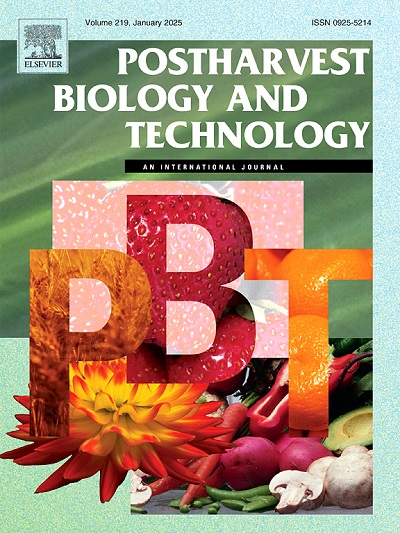综合代谢组学和转录组学分析探讨银杏叶提取物控制甜樱桃采后膨胀青霉的机制
IF 6.8
1区 农林科学
Q1 AGRONOMY
引用次数: 0
摘要
甜樱桃(Prunus avium L.)极易受到膨胀青霉菌(Penicillium expansum)引起的采后腐烂,导致经济损失和健康风险。研究了银杏叶提取物(GBE)增强对杏叶枯病的抗性和保持果实品质的作用。与对照(100 %)相比,GBE显著降低了侵染率(27.78 %),并通过减轻重量损失(5.84 %)、保持硬度和稳定可溶性固体和酸来保持果实品质。GBE还通过提高抗氧化酶活性(PPO, POD)和抑制脂质过氧化标志物(MDA, LOX)来缓解氧化应激。代谢组学和转录组学分析显示,差异表达的代谢物主要富集于黄酮类化合物(槲皮素、山奈酚)和苯丙类化合物(香豆素),而差异表达的基因主要富集于次生代谢、植物与病原体相互作用和激素信号通路。关键途径包括苯丙类生物合成和JA/ sa介导的防御反应,由上调基因(PavPAL、PavCHS、PavLOX2S、PavMYC2)和相关转录因子(PavMYB、PavWRKY、PavNAC)介导。GBE抑制与细胞壁降解相关的基因(PavPG, Pavβ-GAL),同时激活PR蛋白和激素相互作用网络。该研究为合成杀菌剂提供了一种可持续的替代品,为易腐水果采后疾病管理提供了基于天然提取物的策略。本文章由计算机程序翻译,如有差异,请以英文原文为准。
Integrated metabolomic and transcriptomic analysis to explore the mechanisms of ginkgo biloba leaf extract in controlling postharvest Penicillium expansum in sweet cherry
Sweet cherries (Prunus avium L.) are highly susceptible to postharvest decay caused by Penicillium expansum, leading to economic losses and health risks. The efficacy of Ginkgo biloba leaf extract (GBE) in enhancing resistance against P. expansum and preserving fruit quality was investigated. GBE significantly reduced infection rates (27.78 %) compared to the control (100 %) and maintained fruit quality by mitigating weight loss (5.84 %), preserving firmness, and stabilizing soluble solids and acids. GBE also alleviated oxidative stress by enhancing antioxidant enzyme activities (PPO, POD) and suppressing lipid peroxidation markers (MDA, LOX). Metabolomics and transcriptomics analyses revealed that the differentially expressed metabolites were primarily enriched in flavonoids (quercetin, kaempferol) and phenylpropanoid compounds (coumarins), while the differentially expressed genes were primarily enriched in pathways related to secondary metabolism, plant-pathogen interactions, and hormone signaling. Key pathways include phenylpropanoid biosynthesis and JA/SA-mediated defense responses, mediated by up-regulated genes (PavPAL, PavCHS, PavLOX2S, PavMYC2) and related transcription factors (PavMYB, PavWRKY, PavNAC). GBE inhibited genes associated with cell wall degradation (PavPG, Pavβ-GAL), while activated PR protein and hormone interaction networks. The study provides a sustainable alternative to synthetic fungicides, offering insights into natural extract-based strategies for postharvest disease management in perishable fruits.
求助全文
通过发布文献求助,成功后即可免费获取论文全文。
去求助
来源期刊

Postharvest Biology and Technology
农林科学-农艺学
CiteScore
12.00
自引率
11.40%
发文量
309
审稿时长
38 days
期刊介绍:
The journal is devoted exclusively to the publication of original papers, review articles and frontiers articles on biological and technological postharvest research. This includes the areas of postharvest storage, treatments and underpinning mechanisms, quality evaluation, packaging, handling and distribution of fresh horticultural crops including fruit, vegetables, flowers and nuts, but excluding grains, seeds and forages.
Papers reporting novel insights from fundamental and interdisciplinary research will be particularly encouraged. These disciplines include systems biology, bioinformatics, entomology, plant physiology, plant pathology, (bio)chemistry, engineering, modelling, and technologies for nondestructive testing.
Manuscripts on fresh food crops that will be further processed after postharvest storage, or on food processes beyond refrigeration, packaging and minimal processing will not be considered.
 求助内容:
求助内容: 应助结果提醒方式:
应助结果提醒方式:


